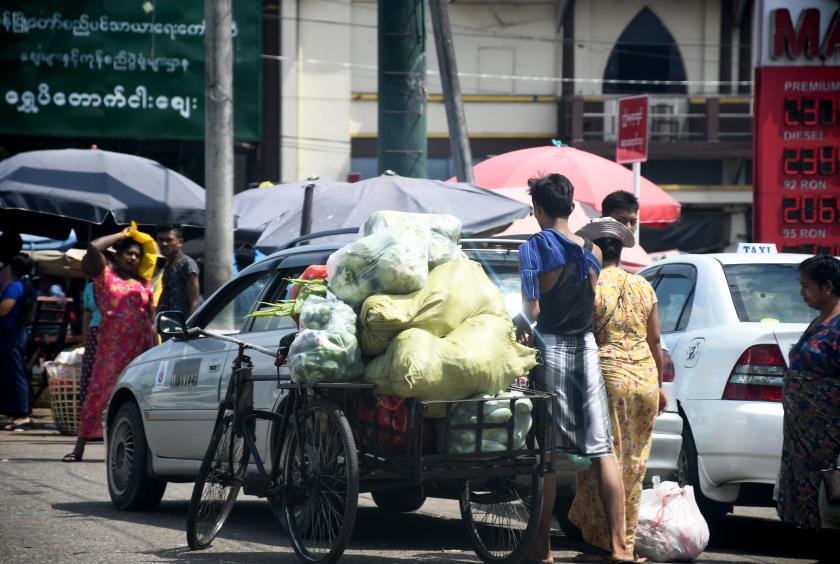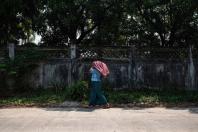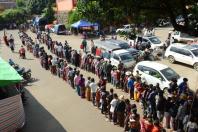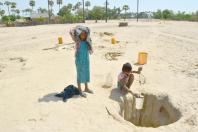This year, the people of Myanmar have significantly suffered from consequences of the poverty that increased markedly in 2022 along with the economic decline since 2021.
Two years after the political change, foreign investors left the country while a lot of factories closed down, thereby contributing to job scarcity and losses.
The Covid-19 pandemic plus the political change have great impact on Myanmar’s economy causing the unemployment rate to increase gradually.
An ILO report said that 1.2 million people lost jobs in Myanmar even in the second quarter of 2021 when a political change came.
There was a significant deterioration in labour market conditions in Myanmar after February 1. Construction, garment, tourism and services were among all the affected economic sectors, ILO pointed out.
In the first half of 2021, estimated working hours of those sectors were lost by 35%, 31% and 25% respectively.
In Yangon City alone, about 300,000 construction workers and about a quarter of over 800,000 garment factory workers lost their jobs.
■ Increasing unemployment rate
A report on the labour force data for 2020-2023 released by the Ministry of Labour shows that Myanmar’s employment rate has increased since 2020.
The data was based on annual household lists from the Population Department, work force and jobs of various types.
The unemployment rate was 0.17% in 2020, 1.33% in 2021, 2.53% in 2022 and 3.69% in 2023.
The Ministry of Labour said that the increased unemployment rate after 2020 was likely to have resulted from waning workforce, business closures and migration during the pandemic.
The ministry’s report also pointed out that as workforce increased yearly, labour market and employment rate could not cover such an increasing workforce.
With the current economic decline, many businesses have stopped their operations, while some have reduced their operation hours about by half.
Moreover, reduced salary rates and lay-offs have led to significant unemployment rates across the country, according to labour organizations.
■ Possibility of higher unemployment rate in 2023
Trading Economics providing economic indexes from 196 countries has reviewed that Myanmar’s unemployment rate is likely to increase more in this year (2023) than last year. The rate was 1.80% in 2022 and is likely to reach 2% in 2023.
The rate was calculated based on able workers, not on young children and retirees.
The organization said 2015 and 2019 were the lowest years of Myanmar’s employment rate seeing 0.8% and 0.7% respectively.
And 2013 saw the highest employment rate over the last decade.
■ Fuel added to the fire
The people of Myanmar are facing soaring commodity prices as the inflation rate increases in parallel with the unemployment rate.
According to Statista based in Germany’s Hamburg, Myanmar’s inflation rate is likely to reach 13.33% in 2023. The organization’s estimate is based on 22,500 data sources from over 150 countries. The inflation rate in 2017 was 4.62%, the lowest over the past five years.
Statista stated Myanmar’s yearly inflation rates from 2007 to 2027. It is expected to be 7.83% from 2024 to 2027.
From 2007 to 2027, the inflation rate was the highest in 2017 with 34.44% and the lowest in 2012 with 0.36%.
■ UNDP survey
UNDP conducted a survey of over 3,000 people from eight poorest townships in Myanmar.
A quarter (24.1%) of people living in those eight townships have often not had any income in the last 12 months, the survey showed.
This is forcing people to adopt coping strategies that threaten their health and wellbeing, including cutting down on how much they eat and consuming less nutritious food, selling assets, such as vehicles, and forgoing medical treatment.
The report found people living in these eight areas are worse on every economic and social indicator when compared to the rest.
With incomes reduced, 27.5% of respondents to the survey from the eight townships reported that in the last 12 months there was a time when someone in their household could not eat nutritious food due to lack of money and more than a third (35.7%) said they were eating less.
With the public healthcare system weakened, the survey found that people are now reliant on more expensive private hospitals and clinics to meet their medical needs.
Yet, with incomes squeezed, many people are simply forgoing healthcare. Over a quarter of all respondents (26.6%) said they or their family often or sometimes go without treatment or medication, and three-quarters said it is the higher charges that makes accessing healthcare more difficult.
More than two-fifths (43.4%) of respondents from the eight townships reported selling assets in the last 12 months. When these assets are used to generate income, such as vehicles, it can make it even more difficult to earn money and recover.
One of the most extreme coping mechanisms was how families interrupted their children's education in order to work, cited by a quarter of households in the eight surveyed townships who had reported taking their children out of school. These lost years of education will impact their ability to seek better employment in adulthood, UNDP reviewed.
"Urban poverty in Yangon has dramatically escalated, and at the heart of this is a loss of jobs and reduced incomes. Supporting people to earn more money through stable employment is a long-term and sustainable way to improve people's health and wellbeing," said Titon Mitra, Resident Representative at UNDP Myanmar.
■ Declining economy of Myanmar
Economists say Myanmar is seeing its negative economic indicators as the economic decline caused by the Covid-19 pandemic worsens after the political change.
Myanmar's economic growth remains "severely diminished" and GDP is expected to increase just 3% in the fiscal year to September, the World Bank said on March 31.
Widespread violence, worsening power shortages and policy failures will continue to disrupt an economy already crippled by political and social turmoil, the World Bank said in a regional report.
"The business environment is unlikely to improve materially while electricity shortages, logistics disruptions, trade and foreign exchange restrictions, and regulatory uncertainty persist," the report said.
The World Bank said Myanmar's economic output will remain well below levels seen in 2019, even as the rest of the East Asian region rebounds from pandemic-era lows.
Myanmar's gross domestic product contracted about 18% in 2021, before growing 3% in 2022, according to the World Bank.
The report said households faced severe pressure due to lower purchasing power and higher food and fuel prices, with the kyat currency plunging around 31% against the U.S. dollar.
Economists comment that Myanmar’s economic decline has mainly stemmed from low foreign investment, domestic regulatory restrictions, instability and withdrawal of existing foreign investments.
With restrictions on cash withdrawals from banks and difficulty seeking loans, the local businesses have to be struggling with their operations.
As the unemployment rate is likely to get higher under such circumstances, all are interestingly waiting and see how responsible officials will act to revive the country’s economy.











